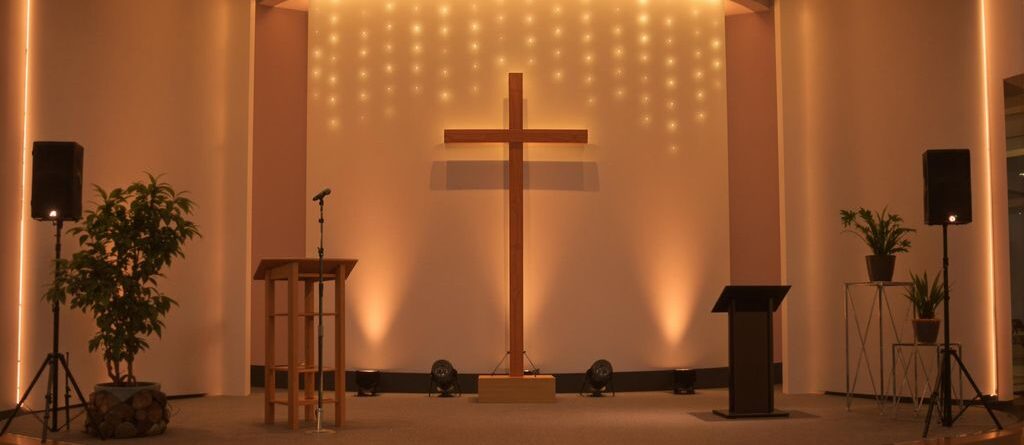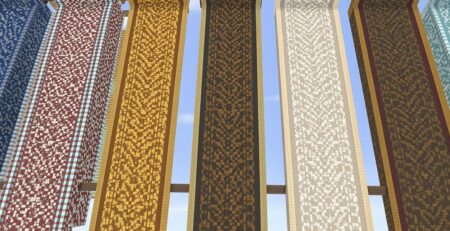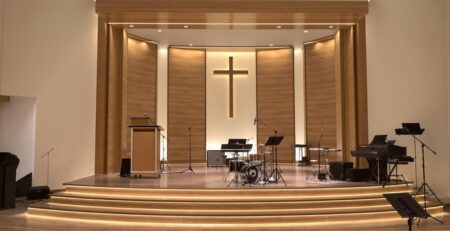Innovative Small Church Stage Design Ideas for Any Budget
Making a church stage look good can be tricky, especially for smaller churches. You want it to feel fresh and inviting, but often, budgets and building layouts get in the way. It’s tough to come up with new ideas when you feel stuck with what you have. But don’t worry, there are lots of ways to make your stage pop without spending a fortune. This article is all about giving you some cool small church stage design ideas to help you create a space that looks great and feels right for your community.
Key Takeaways
- Lighting can totally change the feel of your stage, even in a small space. Think about different colors and how they make people feel.
- You don’t need a huge budget for a nice stage. Simple things like wooden panels or geometric shapes with lights can look really good.
- Get creative with materials. Things like paper crafts or balloons can make a stage unique and they don’t cost much.
- LED lights are great for making a stage dynamic. You can use them for cool visuals or just to add a nice glow.
- When planning, think about money, how to mix old and new styles, and making sure everyone can hear well. Also, get help from others in your church.
Maximizing Impact with Creative Lighting
Lighting can really make or break a stage design, especially in a smaller church space. It’s not just about making sure people can see; it’s about creating an atmosphere that complements the service and engages the congregation. You don’t need a massive budget to achieve a professional look. A few well-placed lights and some creative thinking can go a long way.
Strategic Use of Color and Mood
Color is powerful. Think about how different colors make you feel. Blues and greens can create a sense of peace and tranquility, while warmer colors like oranges and yellows can bring energy and excitement. Using color strategically can enhance the message of the service. Consider investing in some LED tape that can change colors to match the theme of the day. You can also use colored gels on existing lights to create different moods. Don’t be afraid to experiment and see what works best for your space.
Highlighting Key Stage Areas
It’s important to direct the audience’s attention to where it needs to be. This means highlighting the speaker, the worship team, or any other focal points on the stage. Spotlights are great for this, but you can also use strategically placed ambient lighting to create a sense of depth and dimension. Make sure the lighting is balanced and doesn’t create harsh shadows or glare. You want to create a visually appealing space that is comfortable for everyone to look at. Consider these points:
- Use spotlights to highlight the speaker.
- Use ambient lighting to create depth.
- Avoid harsh shadows and glare.
Professional Lighting Design Consultation
If you’re feeling overwhelmed or unsure where to start, consider consulting with a professional lighting designer. They can assess your space, understand your needs, and create a custom lighting plan that fits your budget. While it may seem like an added expense, a lighting design consultation can save you money in the long run by helping you avoid costly mistakes and ensuring you get the most out of your lighting investment. They can also provide valuable insights and ideas that you may not have considered. It’s worth exploring if you’re serious about taking your stage lighting to the next level.
Good lighting is more than just making things visible. It’s about creating an experience. It’s about using light to tell a story, to evoke emotion, and to connect with the audience on a deeper level. When done well, lighting can transform a simple stage into a truly captivating space.
Budget-Friendly Small Church Stage Design Ideas
Simple Wooden Panel Backdrops
Wood panels are a classic for a reason. They’re relatively cheap, easy to work with, and can be customized in a million different ways. Consider using reclaimed wood for an even more budget-conscious and eco-friendly approach. You can paint them, stain them, or even leave them natural for a rustic look. Arrange them in different patterns or heights to add visual interest. It’s a simple way to create a focal point without breaking the bank.
Geometric Shapes with Hanging Lights
Get crafty with cardboard or foam board to create geometric shapes. Triangles, squares, and circles can be arranged to create a modern and eye-catching backdrop. String lights, especially LED lights, can be hung within or around the shapes to add a warm and inviting glow. This is a great way to add depth and dimension to your stage without spending a lot of money. Here are some ideas to get you started:
- Use different sizes of shapes for visual interest.
- Paint the shapes in coordinating colors.
- Experiment with different lighting arrangements.
Using geometric shapes is a great way to add a modern touch to your stage design. It’s also a project that can easily involve volunteers from your congregation.
DIY Mini Bulb Creations
Mini bulb lights, like fairy lights or string lights with small bulbs, can be used to create stunning visual effects. Think about creating a curtain of lights behind the stage or spelling out a word or phrase with the lights. Ping pong balls can be added to the bulbs to diffuse the light and create a softer glow. This is a fun and creative way to add a touch of magic to your stage. You can even change the color of the bulbs to match the sermon topics or the season. Here’s a quick guide:
| Material | Cost (approx.) | Notes |
|---|---|---|
| String Lights | $10-20 | LED lights are more energy-efficient. |
| Ping Pong Balls | $5-10 | Optional, for diffused light. |
| Craft Wire/Clips | $5 | For attaching lights. |
Innovative Material Use for Stage Aesthetics

It’s time to think outside the box! Stage design doesn’t have to be expensive or use traditional materials. Let’s explore some innovative and budget-friendly ways to make your small church stage visually appealing using unexpected materials.
Origami-Inspired Stage Elements
Origami isn’t just for paper cranes anymore! Consider incorporating origami-inspired elements into your stage design for a modern and elegant touch. You can create large-scale geometric shapes from sturdy paper or even fabric. These can be hung from the ceiling or arranged on the stage floor to add depth and visual interest. The best part? You can often reuse materials you already have, making this a very cost-effective option. Casa de Adoración Jabes used Coroplast at their conference to great effect.
Temporary Balloon Installations
Balloons aren’t just for birthday parties! They can be a surprisingly effective and affordable way to add color and whimsy to your stage. Think beyond simple balloon arches. Consider creating balloon walls, columns, or even abstract sculptures.
Here are some ideas:
- Color Themes: Choose colors that complement your church’s branding or the theme of your service.
- Varying Sizes: Use balloons of different sizes to create visual texture and interest.
- Creative Arrangements: Experiment with different arrangements to create unique and eye-catching designs.
Balloons are a great option for special events or holidays, but keep in mind that they are not a long-term solution. They will need to be replaced periodically as they deflate.
Repurposing Materials for Unique Designs
One of the most creative ways to design a stage is by repurposing materials. Old pallets can be transformed into rustic backdrops, fabric scraps can be sewn together to create colorful banners, and even recycled plastic bottles can be used to create unique lighting fixtures. The possibilities are endless! Wooden panels are a great option too.
Here are some ideas for materials to repurpose:
- Fabric Scraps: Sew together to create colorful banners or curtains.
- Old Pallets: Transform into rustic backdrops or furniture.
- Cardboard Boxes: Cut and paint to create geometric shapes or sculptures.
Leveraging LED Technology for Dynamic Stages
LEDs are a game-changer for church stages, especially smaller ones. They offer a ton of flexibility and can really transform the space without breaking the bank. Let’s look at some ways to use them.
Integrating LED Walls for Visuals
LED walls can create a huge impact, especially if you have a large, blank wall on your stage. They’re not just for big churches anymore. You can use them to display lyrics, scripture, or even create cool abstract backgrounds. It’s like having a giant, customizable canvas. If you’re thinking about an LED wall, it’s a good idea to talk to a professional to figure out the right size and resolution for your space. They can also help you pick content that will look great. You can get as creative as you want with the sizes and shapes of the LED panels.
Creative Applications of LED Tape
LED tape is super versatile and affordable. You can use it to add a backlight to your stage curtains, light up the front of the stage, or even create designs on the floor or backdrop. It’s a great way to add color and flair. Consider using different color palettes to match the theme of your service or create a visually appealing effect. Here are some ideas:
- Backlighting for stage elements
- Highlighting architectural features
- Creating patterns on the stage floor
Ambient Lighting with LED Fixtures
LED fixtures are great for creating ambient lighting. You can use them to set the mood and create a welcoming atmosphere. Think about using different colors to create different effects. For example, you could use warm colors for a cozy feel or cool colors for a more modern look. You’ll want to illuminate the stage respectfully. You don’t want the stage too dark to the point where you can’t fully see the person speaking. If your lights are dimmed, you’ll want to highlight different areas, like the speaker. Here are some options to consider:
- Uplighting walls or columns
- Using colored LED bulbs to create a festive atmosphere
- Dimming lights to create a more intimate setting
Using LED technology is a great way to make your church stage more dynamic and engaging. It’s affordable, versatile, and can really transform the space. Don’t be afraid to experiment and get creative!
Practical Considerations for Small Church Stage Design
Addressing Financial Constraints Creatively
Let’s be real, money is often tight, especially for smaller churches. But that doesn’t mean your stage has to look cheap! Think outside the box and get creative with your resources. Instead of buying brand new materials, explore options like repurposing old decorations or asking for donations from the congregation. Maybe someone has some spare lumber or fabric they’d be willing to contribute. You’d be surprised what people are willing to give if you just ask!
- Set a realistic budget and stick to it.
- Prioritize essential elements over fancy extras.
- Look for discounts and sales on materials.
Don’t be afraid to get your hands dirty and do some DIY projects. There are tons of tutorials online for building simple stage elements. Plus, it’s a great way to get the community involved.
Balancing Tradition with Modern Aesthetics
Finding the right balance between honoring tradition and incorporating modern design can be tricky. You want to create a space that feels welcoming and familiar to long-time members, while also appealing to new visitors. Consider incorporating traditional elements in a fresh, updated way. For example, instead of using heavy, ornate fabrics, opt for lighter, more modern textiles in traditional colors. Or, use classic symbols in a minimalist design. Think about the overall feel you want to create and choose elements that support that vision. It’s important to consider the congregational culture when making these decisions.
Optimizing Acoustics and Sound Quality
Sound quality is super important for any church service. A beautiful stage design won’t matter much if the sound is echoing or muffled. Consider the acoustics of your space when planning your stage design. Soft materials like fabric panels can help absorb sound and reduce echo. Avoid using too many hard, reflective surfaces. Also, make sure your sound system is properly set up and calibrated for the space. If possible, consult with a professional sound engineer to get their advice. Good sound is key for worship music stage design.
Here’s a simple table to illustrate the impact of different materials on acoustics:
| Material | Acoustic Effect | Notes |
|---|---|---|
| Fabric Panels | Absorbs sound | Reduces echo and reverberation |
| Hardwood Floors | Reflects sound | Can create echo if not properly treated |
| Acoustic Tiles | Absorbs sound | Ideal for improving overall sound quality |
| Concrete Walls | Reflects sound | Can cause significant echo |
- Use soft materials to absorb sound.
- Position speakers strategically.
- Consider acoustic panels or tiles.
Developing Your Own Small Church Stage Design
Starting with a Blank Canvas
Sometimes, the best way to approach a new stage design is to pretend you’re starting from scratch. This allows for maximum creativity and prevents you from being boxed in by existing elements. Think about it – no preconceived notions, just pure potential. Consider the space itself: its dimensions, natural light (or lack thereof), and any architectural quirks. What feeling do you want to evoke? A blank canvas lets you build that feeling from the ground up.
Researching and Gathering Inspiration
Don’t reinvent the wheel! Look around. See what other churches are doing, both locally and online. Pinterest, church design blogs, and even architectural websites can be goldmines of ideas. Pay attention to the materials they use, the lighting techniques, and the overall aesthetic. But remember, inspiration is different from imitation. Take those ideas and adapt them to your church’s unique style and needs. Think about how vinyl lettering designs could add a unique touch.
Setting Realistic Project Timelines
Okay, this is where things can get tricky. Creative projects always take longer than you think. Be honest about how much time you and your team can realistically dedicate to the project. Break down the project into smaller, manageable tasks, and assign deadlines to each. Account for potential delays, like shipping times for materials or unexpected construction challenges. A well-defined timeline will keep you on track and prevent last-minute stress.
It’s easy to get caught up in the excitement of a new design, but a realistic timeline is crucial. Rushing the process can lead to mistakes, compromises in quality, and burnout among your volunteers. Plan, plan, and plan some more!
Here’s a sample timeline breakdown:
| Task | Estimated Time | Deadline |
|---|---|---|
| Brainstorming & Research | 1 week | July 16, 2025 |
| Design Development | 2 weeks | July 30, 2025 |
| Material Procurement | 1 week | August 6, 2025 |
| Construction & Assembly | 3 weeks | August 27, 2025 |
| Lighting & Sound Setup | 1 week | Sept 3, 2025 |
| Final Touches & Testing | 3 days | Sept 6, 2025 |
Building a Collaborative Design Team

It’s easy to think you can handle a stage design project solo, but trust me, bringing in other people makes a huge difference. Not only does it lighten the load, but you also get a bunch of different ideas and skills that you might not have thought of on your own. Plus, it’s way more fun to work on something like this with friends and fellow church members.
Keeping Designs Simple and Focused
Okay, so you’ve got a team. Great! Now, before everyone starts throwing out wild ideas, it’s important to set some ground rules. The biggest one? Keep it simple. It’s easy to get carried away with fancy concepts, but a clean, focused design is almost always more effective, especially in a smaller church setting. Think about what message you want to convey and let that guide your choices. Don’t try to cram too much into one space. A single, well-executed focal point is better than a bunch of distracting elements. This approach also helps keep costs down and makes the project more manageable for your volunteer team.
Recruiting Volunteers with Diverse Skills
When you’re putting together your design team, don’t just look for people who are "creative." Think about the different skills you’ll need to pull this off. Sure, you want someone with an eye for aesthetics, but you’ll also need people who are good with tools, who can handle lighting, and maybe even someone who knows a thing or two about sound. Don’t be afraid to ask around – you might be surprised at the hidden talents lurking in your congregation. Someone who’s a whiz with custom-printed step and repeat backdrop banners could be a huge asset for creating backdrops. A diverse team brings different perspectives and practical skills to the table, making the whole process smoother and more innovative.
Here’s a quick list of skills to consider:
- Design and aesthetics
- Construction and carpentry
- Lighting and electrical
- Sound and acoustics
- Project management
Fostering Community Involvement in Design
This isn’t just your stage; it’s the church’s stage. So, get the community involved! Ask for feedback on design ideas, hold brainstorming sessions, and let people contribute their talents and resources. This not only makes the design process more inclusive but also creates a sense of ownership and excitement within the congregation. When people feel like they’ve had a hand in creating something, they’re more likely to support it and appreciate it. Plus, you might get some amazing ideas you never would have thought of on your own. Remember, community feedback is important, but it’s also important to get advice from professionals.
Getting everyone involved can be a game-changer. It’s about creating a space that reflects the heart of your church, not just the vision of a few individuals. By opening up the design process, you’re building a stronger connection between the stage and the people who use it every week.
Want to make your team work better together? It’s all about getting everyone on the same page and using their different skills. A good team can make amazing things happen. To learn more about how we can help your team shine, visit our website today!
Conclusion
So, there you have it. Making a church stage look good doesn’t have to break the bank. It’s all about being smart with what you have and getting a little creative. Whether you’re working with a tiny budget or have some extra cash to play with, there are tons of ways to make your stage special. Just remember to keep it simple, think about what works best for your church, and don’t be afraid to try new things. A well-designed stage can really make a difference, helping everyone feel more connected during services. It’s about making a welcoming space, not just a fancy one.
Frequently Asked Questions
Why is stage design important for a church?
A good stage design helps make the church service feel more special and helps people focus on the message. It sets the right mood and can even help tell the story of the sermon.
What’s a good budget for church stage design?
The cost can be very different. You can do a lot with a small budget by using simple materials and doing things yourself. For bigger changes, it might cost more, but there are always ways to save money.
How does feedback from the church community help with design?
Getting ideas from the church members is super important! They can share what they like, what helps them feel connected, and even offer to help build things. It makes the design feel more like ‘ours’.
Can small churches have cool stage designs too?
Yes, you can absolutely make a great stage design even if your church space is small. Focus on smart lighting, simple backdrops, and things that can be moved around easily to make the most of the space.
How often should a church change its stage design?
It’s a good idea to change the stage design a few times a year, maybe for different seasons like Christmas or Easter, or for special sermon series. This keeps things fresh and exciting.
What’s the first step to designing a church stage?
The best way to start is by looking at pictures online, visiting other churches, and thinking about what message you want your stage to send. Then, gather a few helpers and start with simple ideas.











